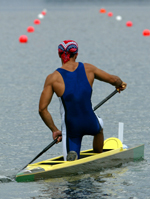
Outer space: Canoeing and Kayaking

Kayak crews use double-bladed paddles. Image: Yanid.
Canoeing and kayaking have ancient origins in traditional communities and the word kayak is derived from the Inuit word qajaq. What's the difference? Canoes are paddled on one side by each kneeling crew member using a single-bladed paddle, whilst kayak crews are seated and use double-bladed paddles, with alternate strokes falling on each side of the boat. Canoes are open but kayaks can be made completely watertight by the clothing of the paddler to an extent that a complete 360-degree roll is possible by capsising into the water and back out again without any water entering the kayak.
At the Olympics we see canoe (C) and kayak (K) races over a straight course of 500 metres or 1000 metres (there will also be a 200m at the 2012 Games, replacing the 500m race for men and in addition to the 500m race for women) with crews of one, two or four paddlers. They are called C1, C2, K1, and K2 to distinguish the boat type and the number of paddlers. Unlike in rowing, there is never a cox: the paddlers have to steer their own course and they all face in the direction of motion.
If we look at the winning times at the Beijing Olympics in the 500m, the men's C1 was won in 1 minute 49.140 seconds while the men's K1 was won in a significantly faster time, 1minute 37.252 seconds. The same trend is maintained for the K2 and C2 events. In fact, the women kayakers are a lot faster than the men canoeists over the same distance. Clearly, the extra stroke rate that is possible with the double blade, as well as the more stream-lined profile of the kayak, gives a consistently quicker ride through the water, and more efficient propulsion for the same amount of human power input.

Canoes are paddled using a single-bladed paddle.
A simple question to ask is whether having lots of paddlers helps or slows the boat down? The kayak with two paddlers has twice as many "engines" to power it but it also has twice as much weight to drag through the water. Which is the dominant factor?
The power required to move the boat through the water is mainly to overcome the frictional drag on the hull created by the water and is equal to the drag force, $D$, times the speed, $V$, through the water. The drag force depends on the area $A$ of the hull in contact with the water. This area is proportional to $L^2$ where $L$ is the length of the boat. The drag force also depends on the square of the speed through the water, so that $$ \mbox{Power needed to overcome the drag} = D \times V \propto L^2V^2 \times V \propto L^2V^3 $$ The volume of the boat is proportional to $L^3$ and also to the number $N$ of crew (we assume they are identical in size and strength), as you need a bigger boat the fit them in! So $L \propto N^{1/3}$, and the $$ \mbox{Power needed to overcome the drag} \propto L^2V^3 \propto N^{2/3}V^3. $$ But the power supplied by the paddlers in proportional to their number: $$ \mbox{Power supplied by crew} \propto N. $$ Since the power required to overcome the drag force is supplied by the paddlers, we must have $N^{2/3}V^3 \propto N$. So we know how the speed of the boat should change with an increased number of paddlers: $$ V \propto N^{1/9}. $$ The increased power supplied by the extra crew slightly outweighs the effect of the increased weight to be shifted through the water – but not by much. The gain from having extra crew increases very slowly with any increase in $N$. If the boats are assumed to proceed at a constant speed (which is not quite true, especially over the longer distances) then we would expect the finish times to be given by the length of the race divided by $V$. So the race times, $T$, should vary with $N$ as $$ T \propto N^{-1/9} $$| N=1 | N=2 | N=4 | |
| Men 1000m K times | 206.323s | 191.809s | 175.714s |
| Women 500m K times | 110.673s | 101.308s | 92.231s |